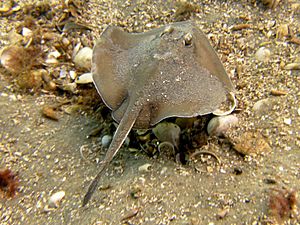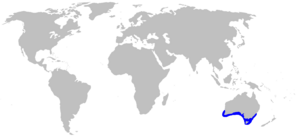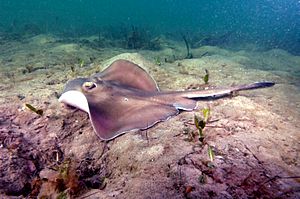Sparsely spotted stingaree facts for kids
Quick facts for kids Sparsely spotted stingaree |
|
|---|---|
 |
|
| Conservation status | |
| Scientific classification | |
 |
|
| Range of the sparsely spotted stingaree |
The sparsely spotted stingaree (Urolophus paucimaculatus) is a type of stingray. It is also known as the white-spotted stingaree or Dixon's stingaree. This ray is common along the southern coast of Australia. It likes to live on sandy areas and in seagrass beds. You can find it from close to shore down to about 150 meters (490 feet) deep. In the northern parts of its home range, it tends to live in deeper water.
This stingaree can grow up to 57 centimeters (22 inches) long. It has a wide, diamond-shaped body. Its top side is usually plain gray with a V-shaped mark between its eyes. Stingarees from southern waters often have small, white spots with dark edges. A special feature is the bell-shaped skin flap between its nostrils. Its tail has a skin fold on each side and a leaf-shaped tail fin, but it does not have a back fin.
During the day, the sparsely spotted stingaree is not very active. It mostly eats small crustaceans like shrimp and crabs. It also eats polychaete worms and other small creatures that live on the seabed. Female stingarees give birth to live young. They feed their babies with a special "uterine milk" inside their bodies. The way they reproduce is a bit different between stingarees from the eastern and western parts of Australia. The International Union for Conservation of Nature (IUCN) says this species is "Least Concern" because not many are caught by fishing.
Contents
About the Sparsely Spotted Stingaree
The sparsely spotted stingaree was first described in 1969. A scientist named Joan Dixon from the Museum Victoria gave it its scientific name. The name paucimaculatus comes from Latin words meaning "few" and "spotted." This refers to the few spots some of these rays have. The first stingaree studied was found in the Bass Strait, near Cape Patton in Victoria. Scientists have noticed that stingarees from the eastern and western parts of Australia have different life habits. They think these groups might need more study.
Where They Live and What They Like
The sparsely spotted stingaree is one of the most common cartilaginous fishes in southern Australia. Its home range stretches from Crowdy Head in New South Wales to Lancelin in Western Australia. This includes all of Tasmania. In recent years, its range has moved further south. This might be because of climate change. In Port Phillip, its numbers grew from 1970 to 1991. This was probably because fishing reduced the number of other animals that competed for food.
This stingaree lives on the bottom of the ocean. It likes many different sandy or seagrass habitats. You can find it in shallow, calm bays and inlets. It also lives on the open continental shelf, sometimes more than 150 meters (490 feet) deep. Stingarees found further north, like in the Great Australian Bight, usually live deeper. They are often found at depths greater than 80 to 100 meters (260 to 330 feet). But stingarees off Victoria and Tasmania are most common in water less than 30 meters (98 feet) deep. Scientists haven't found proof that different ages or sexes live in separate areas. However, they might move offshore during winter.
What Does It Look Like?
The sparsely spotted stingaree has a body shaped like a diamond. It is wider than it is long, with rounded corners. The front edges of its body are almost straight. They meet at a wide angle at its fleshy snout. The tip of its snout barely sticks out from its body. Its small eyes are followed by comma-shaped holes called spiracles. These spiracles have angular or rounded back edges. The outer edge of each nostril has a small knob at the back.
Between its nostrils, there is a bell-shaped flap of skin. This flap has a finely fringed edge. Only one other stingaree, the Kapala stingaree, has a similar nasal flap. Its small mouth has five or six small bumps on the floor, most with forked tips. There are also more small bumps on the outside of its lower jaw. Its teeth are small with oval bases and are arranged in a pattern. It has five pairs of short gill slits. Its pelvic fins are small and rounded.
The tail is about 77 to 98% as long as the body. It is very flat at the base and gets thinner towards the end. The tip has a deep, leaf-shaped caudal fin (tail fin). There is a clear fold of skin running along each side of the tail. It has a stinging spine with jagged edges on its upper surface, about halfway along its length. It does not have a dorsal fin (back fin). Its skin is completely smooth, without any rough scales.
This stingaree is light gray on top. It has a darker V-shaped mark between its eyes. Its underside is white, with slightly darker edges on its body. Most stingarees from the southern part of its range also have a few small, evenly spaced white spots with dark borders on top of their bodies. Young stingarees have a black tail fin, which gets lighter as they get older. The largest one ever recorded was 57 centimeters (22 inches) long.
Life Cycle and Diet
During the day, the sparsely spotted stingaree often rests still on the seabed. It sometimes buries itself in the sand. Its main food is crustaceans. These make up over 80% of what it eats. Small creatures like amphipods, mysids, and shrimps are the most important. Polychaete worms are also a major food source. Sometimes, it also eats molluscs, echinoderms, and small bony fishes. As it grows older, it eats a wider variety of prey. For example, it eats fewer mysids and amphipods. Instead, it eats more shrimp, polychaete worms, and crabs.
The sparsely spotted stingaree can be eaten by the broadnose sevengill shark. It can also have tiny creatures called tapeworms and monogeneans living on or inside it.
Like other stingrays, the sparsely spotted stingaree gives birth to live young. The mother feeds her developing babies with a special, nutrient-rich liquid called "uterine milk." This happens after the babies use up their yolk supply. Females have only one working ovary and uterus, on their right side. They reproduce once a year.
In the eastern group of stingarees, babies are born in spring or early summer. A mother can have one to six babies at a time. Larger mothers tend to have more babies. The babies grow inside the mother for about one year. Newborns are about 15 to 16 centimeters (5.9 to 6.3 inches) long. Males become ready to reproduce when they are about 28 centimeters (11 inches) long and two and a half years old. Females are ready when they are about 27 centimeters (11 inches) long and three years old. They can live for at least 8 years (males) and 9 years (females).
In the western group, mating happens in early or mid-summer. Females only have one or two babies. The babies grow inside the mother for ten months. Births happen in late spring or early summer. Newborns are about 13 centimeters (5.1 inches) across. Males are ready to reproduce when they are about 21 centimeters (8.3 inches) across and three years old. Females are ready when they are about 22 centimeters (8.7 inches) across and five years old. They can live up to 14 years. In both groups, females grow slower but get bigger than males.
Interactions with Humans
The sparsely spotted stingaree is said to be more aggressive than other stingarees. It will use its venomous sting if it feels threatened. This sting can cause a painful injury to a human. People can eat this fish, but it is rarely sold in markets.
Not much fishing happens in most of this ray's home range, like in the Great Australian Bight. However, a good number of them are accidentally caught by commercial fishing boats. This happens off southeastern and southwestern Australia, using nets like beach seines and bottom trawls. The sparsely spotted stingaree usually survives being caught, sorted, and thrown back into the ocean. For now, the number of stingarees caught by fishing seems to be okay. Because of this, the IUCN has listed this species as "Least Concern". There are some small Marine Protected Areas (MPAs) where it lives. These areas help protect the stingaree and other marine life.



